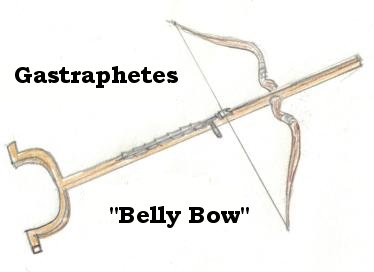
Home

I have a youtube channel with over 1000 Videos!



Wills Pinterest !


Hi, Thanks for visiting my website. My name is Will and if you have questions
or would like to
contribute projects or ideas you can contact me 
A Timeline of Development of the Catapult
We may never exactly know when the first legitimate catapult was developed but it is generally credited with being around the 3rd to 4th Century BC. An interesting thing about catapults and siege engines in general is that they developed over time from smaller weapons. The Catapult is pretty much a derivative and direct result of the Bow and. The catapult is the end result of the desire to make weapons that are bigger, more powerful, and can hurl bigger objects longer distances.
|
Flexion Based Power
The Beginnings of the Catapult is with the Greek Gastrophetes (Belly Bow) This was a bow that was laid out horizontal and braced up against the belly. This way the user could use both hands to draw back the string. It was more powerful than the regular bow.
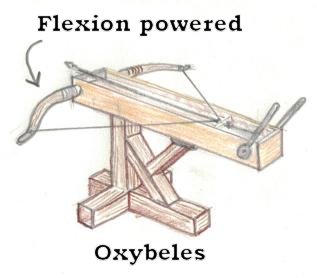 These Belly Bows got larger and more powerful and eventually they were taken off the belly and placed on a stand (This allowed them to get even larger. This new arrangement was called the Oxybeles. If you consider a catapult to be a siege weapon that stands along and is not hand-held then the Oxybeles is the first of this type.
These Belly Bows got larger and more powerful and eventually they were taken off the belly and placed on a stand (This allowed them to get even larger. This new arrangement was called the Oxybeles. If you consider a catapult to be a siege weapon that stands along and is not hand-held then the Oxybeles is the first of this type.
Torsion Based Power
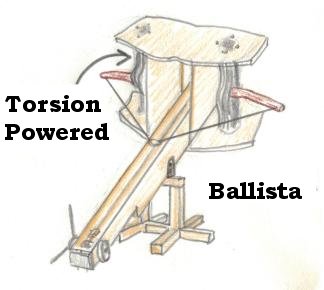 The Ballista - A fundamental change came about in the development of Cataputls with the Ballista. Up until this point all of the typical catapult like weapons used the bending of wood as their source of power. The ballista used Torsion in the form of twisted ropes. This twisted rope torsion power was much stronger than the bending of wood and the ballista got much bigger and much more powerful.
The Ballista - A fundamental change came about in the development of Cataputls with the Ballista. Up until this point all of the typical catapult like weapons used the bending of wood as their source of power. The ballista used Torsion in the form of twisted ropes. This twisted rope torsion power was much stronger than the bending of wood and the ballista got much bigger and much more powerful.
Even though the ballista used torsion for its power it still looked much like a crossbow in that it had two arms. This configuration changed significantly and other types of siege engine configurations came into use.
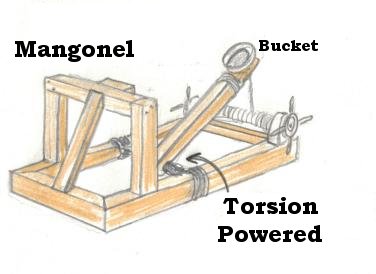
The Mangonel - When we think of a catapult this is often what we think of. Twisted ropes were attached to an arm with a bucket at the end. When the twisted ropes were released the arm shot forward and came to a stop against a crossbar. This would shoot whatever was in the bucket.
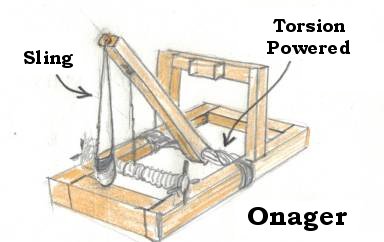
The Onager - This is an interesting variation on the Mangonal in that instead of a bucket it had a rope and sling.
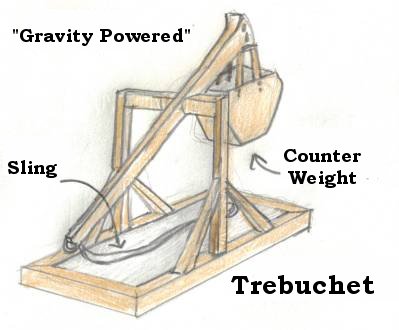 The Trebuchet - Often considered to be the height of Siege Engine making because its simplicity allowed tremendously large ones to be made. It used gravity as its form of energy. This is what made it so simple.
The Trebuchet - Often considered to be the height of Siege Engine making because its simplicity allowed tremendously large ones to be made. It used gravity as its form of energy. This is what made it so simple.
 The Catapult - A History
The Catapult - A History
A Major Contribution to the History of Technology and Ancient Warfare
The most recognized military device of ancient times and the source of continued fascination and popular appeal, the catapult represented a major shift in the conduct of warfare. In The Catapult: A History historian Tracey Rihll uses ancient sources and the latest archaeological findings to tell the story of this first machine of war. Dispelling any notion that the catapult was precision engineered in the modern sense, the author explains how a robust formulaic design allowed a variety of machines and missiles to be built and used for particular battlefield conditions or military tasks. Complete with original illustrations, maps, and two appendices detailing both the formulas for catapult construction and known catapult remains, The Catapult is essential reading for those interested in the history of warfare and technology.

Ancient and Medieval Siege Weapons: A Fully Illustrated Guide To Siege Weapons And Tactics
In this richly illustrated guide, author Konstantin Nossov masterfully analyzes and recreates the weaponry, tactics, and stratagems of the ancient world. He offers first a comprehensive history of siege warfare in Ancient Egypt, Assyria, Judea, Persia, Greece, and Rome as well as Gaul, the Byzantine Empire, the Muslim world, and Medieval Europe. Discover, among other weapons, how scaling ladders, battering rams, borers, siege towers, throwing machines, and finally cannons developed over time. Numerous charts, illustrations, photographs, and tables explain how engineers constructed and adjusted these weapons and how warriors employed them on the battlefield. Chapters on methods of attack and defense show the weapons in action and reveal the various strategies used to implement and to overcome them. Based on an in-depth analysis of the work of ancient engineers, historians, and generals-including Apollodorus, Herodotus, Julius Caesar, Leonardo da Vinci, Livy, Plutarch, Thucydides, Vitruvius, and others- Ancient and Medieval Siege Weapons not only shows you how to recreate the siege weapons themselves but provides a deeper, clearer picture of the history of war.
![]()






